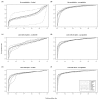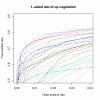A comprehensive re-analysis of the Golden Spike data: towards a benchmark for differential expression methods
- PMID: 18366762
- PMCID: PMC2324099
- DOI: 10.1186/1471-2105-9-164
A comprehensive re-analysis of the Golden Spike data: towards a benchmark for differential expression methods
Abstract
Background: The Golden Spike data set has been used to validate a number of methods for summarizing Affymetrix data sets, sometimes with seemingly contradictory results. Much less use has been made of this data set to evaluate differential expression methods. It has been suggested that this data set should not be used for method comparison due to a number of inherent flaws.
Results: We have used this data set in a comparison of methods which is far more extensive than any previous study. We outline six stages in the analysis pipeline where decisions need to be made, and show how the results of these decisions can lead to the apparently contradictory results previously found. We also show that, while flawed, this data set is still a useful tool for method comparison, particularly for identifying combinations of summarization and differential expression methods that are unlikely to perform well on real data sets. We describe a new benchmark, AffyDEComp, that can be used for such a comparison.
Conclusion: We conclude with recommendations for preferred Affymetrix analysis tools, and for the development of future spike-in data sets.
Figures







References
-
- Shi L, Reid LH, Jones WD, Shippy R, Warrington JA, Baker SC, Collins PJ, de Longueville F, Kawasaki ES, Lee KY, et al. The MicroArray Quality Control (MAQC) project shows inter- and intraplatform reproducibility of gene expression measurements. Nat Biotechnol. 2006;24:1151–61. doi: 10.1038/nbt1239. - DOI - PMC - PubMed
Publication types
MeSH terms
LinkOut - more resources
Full Text Sources

